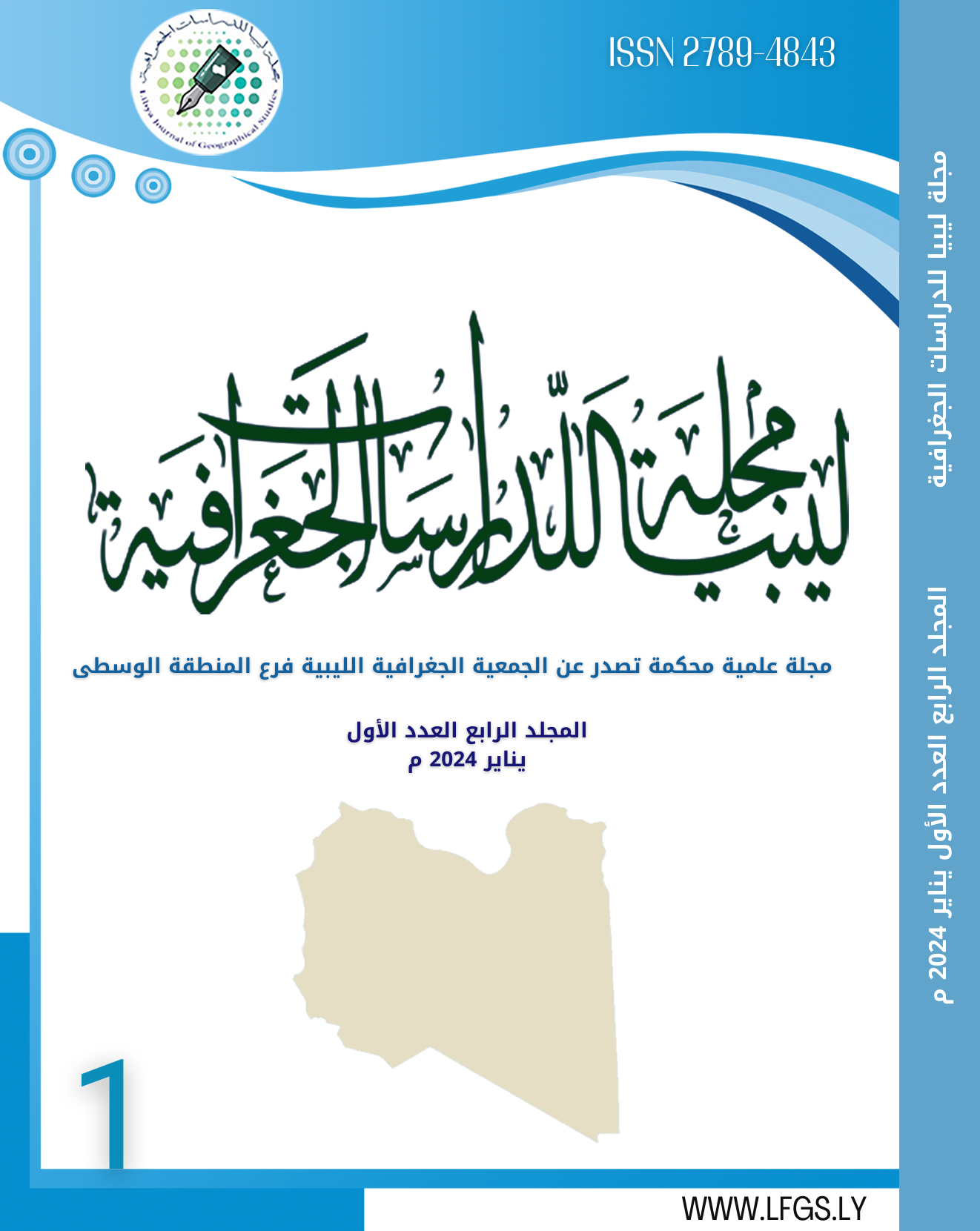Flat semi-playa (Alssd) in the Tobruk region, northeastern Libya, Geomorphological study
DOI:
https://doi.org/10.37375/jlgs.v4i1.2542Keywords:
Flat semi-playa (Alssd), surface sediments, two parallel breaks, breaks and cracks, structural weaknessAbstract
The semi-playa flat (Alssd) is considered one of the important plain areas in the Tobruk region, It is one of the largest flat areas in it. And it is characterized by a semi-flat surface, and it consists of fine-grained sediments, with horizontal stratification, representing the remnants of the sediments of closed fresh water bodies (ponds and lakes) that were formed during previous periods of time during which climatic conditions prevailed. More moisture than the current conditions. Its area is 95.5 square kilometers, That is, about 15% of the area of the Tobruk region, which has an area of 648 km2. Its surface slopes towards the west and northwest, from an altitude of 90 m south of the Al-Marsas area to 10 m south of the Ain Al-Ghazala area in the west, with a slope rate of 23%. Limestone rocks formed the basis of 69.67% of the study area, which are Tertiary formations. While the components of the fourth time constituted 30.33% of the study area, represented by river sediments, beach sediments, and Sebkha sediments.
It seems that the surface of the semi-playa (Alssd) was linked in its origin and development to the coastal conditions and geological events that the study area experienced, as it formed between two parallel fractures along with many breaks and cracks, as the surface took the shape of a rectangle, and it is linked to areas of structural weakness in the study area.
It is likely that the sediments of Alssd surface were created as a result of the accumulation of fine sediments of silt, calcareous mud and fine sand in the form of thin stratified horizontal layers. These sediments accumulated in a fresh water medium represented in many ponds and lakes that prevailed during the fourth time (Pleistocene and Holocene), and it seems that the surface sediments of the flat, according to previous studies, ranged between 125-150 thousand years ago.
The average sizes of surface sediments among gravel amounted to 4.06% of the total samples, the average percentage of sand of different sizes reached 82.65%, and the average percentage of coarse and medium silt reached 13.29%.
Keywords: Flat semi-playa (Alssd), surface sediments, two parallel breaks, breaks and cracks, structural weakness.
References
أولاً: المراجع العربية:
- أبوراضى، فتحي عبدالعزيز، (2008)، المناخ والبيئة ومشكلاتهما المعاصرة، دار المعرفة الجامعیة، الإسـكندریة.
- أبونقطة، فلاح محمود، (1995)، علم التربة، الجزء النظري، مديرية الكتب الجامعية، جامعة دمشق، سوريا.
- إمبابي، نبيل سيد، عاشور، محمود محمد، (1985)، الكثبان الرملية في شبه جزيرة قطر، مركز الوثائق والبحوث الإنسانية، الجزء الثاني، الدوحة، قطر.
- جودة، حسنين جودة وآخرون، (1991)، وسائل التحليل الجيومورفولوجي، الطبعة الأولى، بدون ناشر، القاهرة.
- جودة، حسنين جودة، (1975)، أبحاث في جيومورفولوجية الأراضي الليبية، الجزء الثاني، منشورات جامعة بنغازي.
- الرشيدي، عويس أحمد، (2002)، جيومورفولوجية البلايا في منخفض الفرافرة- بالصحراء الغربية، رسالة دكتوراه، (غير منشورة)، كلية الآداب، جامعة عين شمس، القاهرة.
- شرف، عبدالعزيز طريح، (1963)، جغرافية ليبيا، مؤسسة الثقافة الجامعية، الإسكندرية.
- شرف، محمد إبراهيم محمد، (2008)، جغرافیا المناخ والبیئة، دار المعرفة الجامعیة، الإسكندرية.
- شعبان، فاطمة محمد محمود، (2023)، الخصائص المناخية وأثرها على التربة بمنخفض سيوة باستخدام نظم المعلومات الجغرافية (دراسة في المناخ التطبيقي)، مجلة كلية الآداب، جامعة بورسعيد، العدد 24، الجزء الأول، إبريل.
- الضراط، علاء جابر، (2004)، التصحر في منطقة البطنان- شمال شرق ليبيا دراسة في الجغرافية الطبيعية، رسالة ماجستير، (غير منشورة)، معهد البحوث والدراسات العربية، القاهرة.
- عاشور، محمود محمد، (2003)، أسس الجغرافيا الطبيعية، بدون دار نشر، القاهرة، الطبعة الثانية.
- عبد العالي، شفيق إبراهيم، واخرون، (2002)، كيمياء الأراضي، مطبعة مركز جامعة القاهرة للتعليم المفتوح بجامعة القاهرة، القاهرة.
- المسلاتي، أمين، (1995)، التطور الجيولوجي والتكتوني، الجماهيرية دراسة في الجغرافيا، تحرير: الهادي مصطفى أبولقمة وسعد خليل القزيري، الدار الجماهيرية للنشر والتوزيع والإعلان، سرت، الطبعة الأولى.
ثانياً: المراجع الأجنبية:
- Al Dahaan, Saadi, and ether (2020), Sedimentary Rocks, University of Kufa. Faculty of Science. Department of Geology.
- Barr, F.T and Weegar, A.A (1972) -Stratigraphic nomenclature of the sirte Basin, Libya. Tripoli.
- Barry, R.G. (1969): Evaporation and Transpiration, in Chorley water, Earth and Man: A synthesis of Hydrology, Geomorphology, and socio- Economic Geography, Methuen & Co. Ltd, Bristol, Great Britain.
-Bellini, E (1968): Biostratigraphy of the ALjaghbob formation in eastern Cyrenaica, Libya. Proceeding of the 3 rd. African micro pal. Colluq. Cairo.
-Cook, R.U., & Warren, A., (1973): Geomorphology in deserts. B. T. Bats ford Ltd., London.
- Desio, A. (1971) Outlines and Problems of the Geomorphological Evolution of Libya from the Tertiary to the present day, Symposium on the Geology of Libya, Tripoli.
-Folk, R.L & Ward, W.C (1957): Brozes River bar in the significance of grain-size parameters, Journal of Geology, V.62.
-Folk, R.L. (1974): Petrology of Sedimentary Rocks. Hemphill Publ. Co., Austin, Texas.
-Folk, R.L., (1997): Petrology of Sedimentary Rocks, Hemphill Pub. Co. Austin, Texas
- Industrial Research Centre, (1974) Darnah sheet, Explanatory Booklet, Tripoli, Jamahiriya, Libya.
- Industrial Research Centre, (1977) Bir Hacheim sheet, Explanatory Booklet, Tripoli, Jamahiriya, Libya.
-Kiehl, J., and K. Trenberth, 1997: Earth’s annual global mean energy.
budget. Bull. Am. Meteorol. Vol. 78, No. 2, February.
- Kleinsmiede, W.F.J and Van den Berg, N.J. (1968) Surface geology of the Jabal al Akhdar, Northern Cyrenaica, Libya, Tripoli.
- Pietersz, C.R, C.R. (1968) Proposed nomenclature for rock units in northern Cyrenaica .In Geology and Archaeology of northern Cyrenaica, Liby,Tripoli.
-Saad. N.M., (1977): Mineralogy and geochemistry of lake deposits in El-Wadi El-Gedid area. E.A.R., Ms.c. Thesis, Fac. of Sci., Ain Shams Univ.
- Selley, R. C., 1982. An Introduction to Sedimentology. 2nd edit. Academic Press, Inc. London, Orlando, San Diego. New York, Toronto, Mont read, Sydney, Tokyo.














